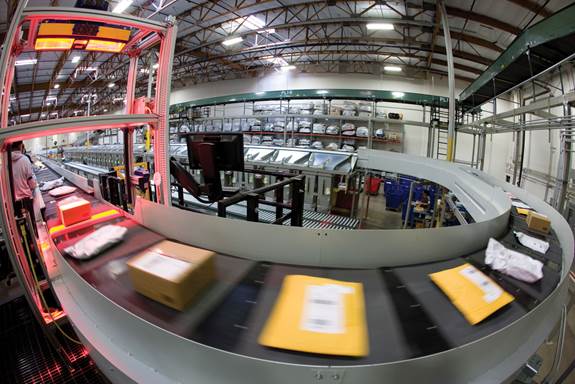Gain More Control over Your Supply Chain

The demands on medical device manufacturers to reduce costs, comply with additional regulations, and ensure product security are putting increased pressure on the supply chain. As companies try to conserve money and resources for product development, product launch, and potential mergers and acquisitions activities, operations and supply chain management teams should be collaborating to reevaluate logistics processes. “Logistics extends the capability of the manufacturer,” says Robin Hooker, director of healthcare sector marketing at UPS. “It enables new market access in a way that can be either very efficient, or capital or resource intensive.”
Inventory, Inventory, Inventory
When expanding into new markets, companies can begin by looking for gaps in visibility in the supply chain to reduce excess inventory. “Once a product leaves the manufacturer or distributor, it will often travel through many hands and then get lost in the system,” says Craig Simon, President and CEO of FedEx SupplyChain. “Perhaps a sales rep transferred the device to a co-worker but didn’t record it. Or, the hospital may have moved the consigned inventory to the operating room without reporting back to the manufacturer. Because systems can lose track of the goods, there is a tremendous amount of duplication.” Poor visibility is even more complicated in international (especially emerging) markets, as automation is not as advanced as in the United States and Europe.
Taking excess inventory out of the field and consolidating it into a regional facility can enable faster stock replenishment and the ability to send bulk shipments from one location versus several shipments from multiple facilities. There’s no one-size-fits-all solution to optimizing the supply chain, and it is essential to understand modes, service level and service commitment needs for consumers or receivers of products, as well as storage and transportation needs based on product. “Does every product need to go at the next base service level, or can some of this product that is regionally close to the network be shipped in a ground fleet that still makes the next-day or two-day service?” asks Hooker.
Security and Product Integrity
In a recent Frost & Sullivan survey, 83% of executives cited ensuring product integrity and security as “extremely important”. As the healthcare market continues to globally expand, companies must provide security within the supply chain by also planning for the unexpected. When companies are assessing their operations strategy or preparing for facility expansion, contingency planning should include designating an alternative distribution site as well as having an additional transportation capability to prepare for an unforeseen event. “When a logistics network is being evaluated for optimization and efficiency, it is a good opportunity to discuss strategies to build in resiliency at the same time,” says Hooker. “In many cases, optimization and business continuity initiatives complement each other.” Manufacturers can work with a third-party logistics provider to develop strategic plans, leveraging the knowledge that their partner has in emerging healthcare markets and regulations to mitigate risks associated with unplanned events.
Monitoring environmental conditions in transit is an important aspect to assuring security and product integrity. As regulatory bodies increase scrutiny and device audits, companies should pay extra attention to maintaining a temperature-controlled environment, according to Simon. Sensor-based logistics provides real-time visibility, monitoring location, temperature, humidity and light exposure of shipments in transit.
Unique device identification will continue to play a significant role in device tracking in the supply chain, as FDA recently release the draft guidance, Unique Device Identification: Direct Marking of Devices. “In the future, most devices will essentially have their own social security number, and we’ll know everything about them within the supply chain—where a device was made, where it’s going, and where it’s been,” says Hooker. “Firms that are forward-looking will leverage this information for business value, and not just for regulatory compliance. They’ll use it to redistribute their inventory, drop inventory levels throughout the supply chain, and run a better balance sheet, because they’ll have visibility to their product at a singular level.”
Continuous Improvement
In an ever-changing supply chain environment, it’s important for logistics professionals to maintain a culture of continuous improvement. “These elements often require a fresh approach to strategy that will help determine where inventory should live, opportunities to consolidate inventory, and whether a change in the mode of transportation is warranted,” says Simon. “It’s critical that medical device manufacturers and logistics teams work closely with product designers and sales teams to help ensure they’re designing supply chains specific to new, and often higher-value, products that will require differentiated capabilities.” However, companies must strive to achieve a balance, as too much change is not effective either. If a company redesigns a warehouse more than once a year, for example, efficiencies will most likely suffer. “While we continue to look for ways to optimize, supply chain professionals must also ensure they’re not changing so much that they entirely disrupt systems in place,” says Simon.
Domestic: We’re seeing a reluctance to develop solutions that enable medical device reps to engage in what they do best, which is to sell. Too often, they get caught up in supply chain operations. They’re carrying around trunk stock and inventory, and with the new hospital procurement models, we’re seeing a transition that involves procurement taking the lead instead of the surgeon-rep relationship. That’s going to challenge medical device firms to transform their supply chain operations.
Reluctance to outsource: The medical device industry is still behind the curve and reluctant to outsource supply chain spend; they want more control. That poses a problem for freeing up capital and being responsive to market needs.
Global challenges: Implementing an asset-light distribution network. In today’s economy of heightened mergers and acquisitions, establishing collaborative models that dovetail small portions of a manufacturer’s supply chain with capabilities that build out a global network creates an asset-light preservation strategy for firms. It enables them to simultaneously hit multiple markets without the regulatory burden, and regulatory barriers are one of the top headwinds in terms of market expansion.